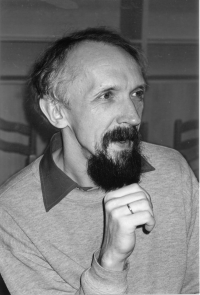
Victor A. Vassiliev
This issue of MMJ is dedicated to Victor Vassiliev—a famous mathematician, a wonderful personality, and our dear friend,—on the occasion of his 50th birthday.
Victor is one of the world leaders of research in topology, singularity theory, integral geometry, partial differential equations, computational complexity, and combinatorics.
He started his research under the guidance of V. I. Arnold by studying the asymptotics of complex exponential integrals. He related these asymptotics with the singularities of Legendrian and Lagrangian mappings and studied the corresponding characteristic classes. The development of these results led to the construction of a complex of singularities and to the discovery of numerous restrictions on the coexistence of singularities. The further study of this complex (now known as the Vassiliev complex) led to the discovery of new, previously unknown characteristic classes of singularities.
Perhaps Vassiliev's most important research results concern the homology of complements to discriminants in functional spaces. Discriminants are sets of degenerate functional objects, while their complements consist of non-degenerate ones. Vassiliev constructed, under very general assumptions, a spectral sequence computing the corresponding homology and yielding powerful invariants. He developed the stability theory for the cohomology of complements to discriminants. The complement to the discriminant of a singularity (in the base of its versal deformation) is naturally embedded into the complement to the discriminant of more complicated singularities, which leads to a homomorphism of the corresponding cohomology rings. Vassiliev proved that these homomorphisms stabilize (as the complexity of the singularity grows), whence defining stable cohomology rings, and computed these rings in various situations. He invented explicit and efficient ways to compute topological characteristics of complements to discriminants, as well as implicit means to establish isomorphisms between these characteristics of different spaces. His spectral sequence, when applied to spaces of polynomials, stabilizes, which allows one to prove results of Smale–Hirsch type for spaces of maps with prescribed singularities. He also extended this stabilization theory to some other kinds of topological invariants, including the (weak) homotopy type. This fundamental work is distinguished by the originality of the results obtained.
In the 1990ies Vassiliev applied his spectral sequence to the study of knot and link invariants in 3-space, obtaining what he called finite type invariants. The role of these invariants (now known as Vassiliev knot invariants) in the algebra of all invariants is that of polynomials in the algebra of smooth functions. This result made him famous overnight, and led to a total revision of knot theory. The universal integral for Vassiliev invariants introduced by Kontsevich, which is a solution to the Knizhnik–Zamolodchikov equation, allowed Kontsevich to show that Vassiliev's relations form a complete set of relations and established a deep relationship between the invariants and quantum field theory. It puts the so-called polynomial invariants, including most up-to-date quantum ones, into a framework of very general nature, extending our knowledge of the very essence of these invariants, and changing the settings of the problems dramatically.
Vassiliev's research of knot and link invariants initiated an avalanche of publications all over the world. A significant part of talks at numerous international conferences on knot theory concerns his theory. Vassiliev presented a plenary talk on discriminants and their complements at the International Mathematical Congress in Zürich in 1994.
Vassiliev's work on topological complexity of zero-finding for univariate polynomials was a crucial improvement of Smale's results obtained earlier. He gave an asymptotically sharp estimate for the topological complexity by elegantly proving the lower estimate that coincides, asymptotically, with Smale's upper one.
Among other results of significant interest by Vassiliev, one should mention the most general formulas of Picard–Lefschetz type for the ramification of cycles on singular complex varieties, his study of the algebraicity of the potential of an algebraic hypersurface in Euclidean space, the generalization of Newton's nonquadrability theorem to the multidimensional case. A great achievement is the explicit computation of Petrovskii characteristic class for simple singularities, which solves the Atiyah–Bott–Gċrding problem on lacunas of hyperbolic partial differential equations. An important result in interpolation theory is an asymptotically sharp estimate for the minimal dimension of the space of functions on a manifold interpolating any function with given values at any prescribed k points.
Victor Vassiliev is one of the most universal mathematicians of the modern world. He stresses the unity of mathematics, studies and develops its relationship with classical science.
In the last years Vassiliev has led an almost desperate but valiant struggle for mathematical education in Russia and worldwide. His struggle has always been characterized by sincerity, exemplary honesty, and the nobility that has distinguished him from his very youth.
From the very first years of the Independent University of Moscow, Victor is one of the key figures in the life of the university. He gives courses in geometry and topology that vary from elementary to advanced ones and, for many years, heads the seminar `Knots and discriminants'. All of the courses are marked by originality and developed on the basis of his personal views and achievements, thus inviting the students in the field of research. His introductory course in topology is very popular and has been published as a textbook.
We wish Vitya many happy years of fruitful work, both in the research he knows so well and enjoys, and in the public life that may sometime be difficult to bear.
V. Arnold, V. Bukhstaber, Yu. Ilyashenko,
M. Kazarian, A. Khovanskii, S. Lando,
S. Novikov, A. Sossinsky, M. Tsfasman

